Fall 2014 A publication of the Wildlife Division—Getting Texans Involved
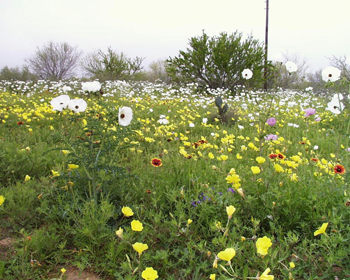 Drought and Wildlife Considerations
Drought and Wildlife Considerations
Photos © Jimmy Kuntz
By Jimmy Kuntz
The first thing a manager must do is plan for the next drought. One of the first things I look at when visiting a property is the available water sources that consistently provide water and their distribution. Ten shallow tanks on a thousand acres will not help much if they dry up during a drought. Consider running water lines to some tanks to offset evaporation. If water is piped to troughs or other manmade water sources, allow them to overflow slightly. This will create an oasis effect that will benefit all wildlife species, even those that do not require standing water, and wildlife seems to prefer drinking water from the ground rather than a trough. Water distribution will depend on your budget, but creating more water sources can give you the greatest benefit to cost ratio of any management practice available. I have yet to see a property in South Texas with too many water sources.
Managing the vegetative component of the habitat is equally important. Forbs are often preferred forage for many wildlife species, but due to our sporadic rainfall events they are often not available. In South Texas we rely on shrubs and cacti as the most dependable forage base available throughout the year. High ungulate and livestock densities can impact these woody plants, as well as reduce residual herbaceous cover needed by many animals going into a drought. I often tell land managers to manage for a deer density that does not impact the habitat during a drought. That way when the rains return every animal will come out of the drought in decent body condition, and the habitat can quickly recover. To check the browsing pressure on woody plant species, biologists can conduct stem count index surveys. Grazing pressure is important to the health of the plant because of droughts. Woody plants are hardy, but when all their leaf material is continuously removed, they rapidly deplete stored energy in their roots in order to produce leaves to carry on photosynthesis. These plants can easily do this when rainfall is adequate, but when a drought occurs, or when the plants are returning from dormancy, the inability to produce food through photosynthesis will lead to the death of the plant.
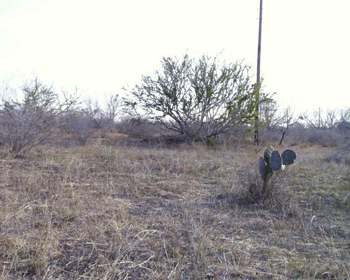
Flexibility in grazing regimes is important. Rotational grazing is beneficial to wildlife, but a good livestock manager should also have a plan to destock based on rainfall events and accumulated rain throughout the year. Grazing at light to moderate levels is usually best, leaving enough residual cover for ground nesting birds, small mammals, and other wildlife. One old adage for grazing was take half, leave half, however, in a drought situation 25% of the total plant material can be lost to termites and other insects, trampling, and decay. When managing for wildlife leaving 2/3 of the standing plant biomass may be a better option when going into a drought.
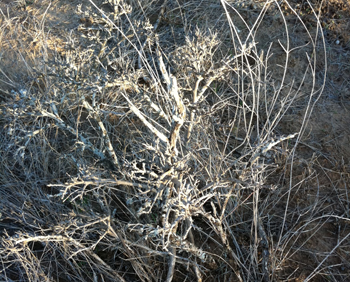
For game species, understanding animal health and productivity in relation to drought events can be a key in planning harvest rates and strategies. Many of our woody plant species have evolved under sporadic rainfall, and can tolerate a short term drought. Tree species requiring more water like hackberry, cedar elm, and live oak suffered the worst in the 2011 drought. This drought was one of the worst droughts on record, but other drought events have affected wildlife populations just as negatively in the last ten years. Often the length of drought conditions can affect wildlife populations more than the severity of a short term drought, at least in South Texas. In 2010 rainfall was consistent and above average throughout the year in most areas of South Texas, allowing for a lag effect before the impacts of the 2011 drought began to be felt in some areas. At my lease just north of Kerrville several springs still provided good water in 2011, but due to reduced rainfall the past three years two of our consistent springs have gone dry. Animals also show a lag effect in relation to rainfall. Deer in poor condition may take longer to gain back lost weight coming out of winter, and even if spring rainfall is adequate antler growth and fawn survival may be affected. Often it takes at least two years of consistent rainfall to produce a "boom" year for quail.
In summary, we all know drought can impact the health and survival of wildlife species. In the wildlife community we often say what separates a good manager from the rest is how they prepare for and manage for drought. In semi-arid areas such as South Texas flexibility and planning are key in managing healthy ecosystems and wildlife populations.
Daniel Kuntz is a technical guidance biologist working out of Alice.
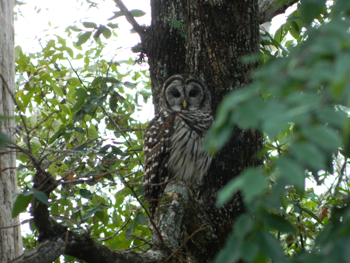 The Drought and Our Backyard Wildlife
The Drought and Our Backyard Wildlife
Photos © Sharon Steffen
By Sharon Steffen
Our bird bath had the usual visitors of cardinals, blue jays, wrens, mockingbirds, robins, chickadees, titmice, bluebirds, warblers, doves, woodpeckers (Pileated and Ladder-backed) and squirrels. We would hear the owls in the woods but rarely saw them up close. Several of our neighbors maintained bird feeders during the drought. This particular year brought additional and unusual guests to our yard.
One unexpected treat was a barred owl. At first, it would sit in the trees surrounding the birdbath. As it got used to our presence, it came down to the birdbath around 4 o'clock each evening and would sit with its talons in the water. The need for water was greater than the owl's fear of us. Since the owl had a hard time drinking at the birdbath, we put a ceramic pot outback with water which made it easier for the owl to drink. It still came and dipped its claws in the birdbath however. It became tolerant of our presence as we sat outside taking pictures. Sometimes during the day, we would look up and see the owl sitting up in the trees near the birdbath watching us. When the owl left, the other birds came scurrying back and started jostling for their position on the birdbath.
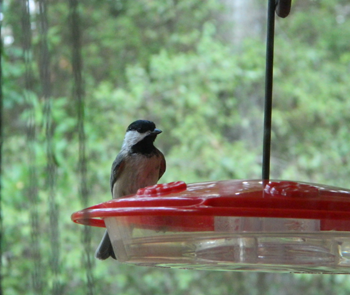
Another unusual thirsty guest was a coyote. We had seen the coyote several times cutting through our yard to get to the woods behind us. One day around noon, I looked out to see what looked to be a scraggly dog getting a drink out of the birdbath. It was the coyote. It was always traveling in a west to east direction through our yard. We have a ditch that cuts through our yard and it is the natural drainage system for our street and part of it is heavily shaded. The ditch is dry except when it rains or when we water the vegetation to maintain erosion control. The shaded area may have enticed the coyote to use our property during this hot, dry weather. Many of the birds would get down in the little puddles to drink and bathe also. Any small amount of water was appreciated by all the living creatures in our area.
The different species of birds don't usually co-mingle at the birdbath. During the drought, the different species were more tolerant of each other. We would see cardinals and wrens each staking out a section on the rim of the birdbath at the same time, eyeing each other before getting a drink. When it came time for a bath however, they seemed to take turns. Only one type of bird would bathe while the others would wait in the nearby trees and shrubs. The only exception to this routine was when the barred owl came for its evening ritual. You knew the owl was in the vicinity because all the birds, squirrels and rabbits would abruptly leave. That was our cue to get the camera.
Our hummingbird feeders were another source of moisture that the wrens, titmice, chickadees and chameleons explored. The need for water was so critical, any source of moisture, no matter how small, was explored and utilized.
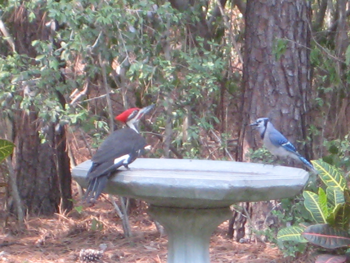
The drought of 2011 also brought the deer into our wooded backyard area. We had not seen deer for several years. Then one morning around 9 o'clock, I was walking the dog and we came upon several deer in the utility easement separating our property from the woods behind us. The need for water and food brought them back early each morning and evening. We put an old plastic tub filled with water in the wooded area so they didn't have to come near the house for water. This prompted us to put out containers of varying heights with water for the raccoons, opossums and rabbits we routinely saw in the wooded part of our property. We were trying to keep the water sources in their natural environment so the wildlife would feel safe and keep them away from our house. We didn't want to add more stress to the animals than they were already experiencing and we were still able to observe and enjoy the wildlife from a distance. One of our aerobic septic sprinklers was positioned to spray a portion of our wooded area, which helped keep a small area of the understory shrubs, trees and weeds green. This was a natural food source for some of the wild animals, especially the rabbits and the deer. The deer would eat any green leaf since their food sources were dwindling. The conditions were extreme and we were all in survival mode. In September of 2011, Magnolia, which is 12 miles from us, experienced a wildfire. This further displaced and stressed the animals in the area. Fortunately, our area was spared from the flames.
In 2012, having survived the extreme weather of 2011, we were gifted with another unusual sight. My husband looked out the window about 4 o'clock in the evening and saw at least 10-12 bluebirds in and on our birdbath at the same time. This went on for at least a week. It was quite a treat to watch each evening. Until then, we had seen only one or two bluebirds at a time. We didn't know where they were nesting, but we enjoyed their evening visits. Even today, we occasionally get 5-6 bluebirds at a time bathing and drinking at our birdbath.
We humans share a common denominator with all the animals and plants to survive. Besides clean air, food and shelter, we can't survive without water.
Sharon Steffen is a Master Naturalist in Montgomery County.
Water Management in Your Backyard
By Mark Klym
In those movies, the desperate cowhand often found water when he found a wildlife trail or followed a flying insect. Water is critical to wildlife too and when we waste it, wildlife often suffers.
One area in which we can have a significant impact on our water use is in our gardens. Estimates of how much water Americans use each year in their gardens are staggering - some show this consumption as high as 22% of all the water we use each year. If we were to reduce this use significantly, it would have a definite impact on our water resources and therefore on wildlife habitat.
There are ways we can reduce the demand our gardens make on water supplies. The first is rather obvious - use plants that present a low water demand. The best way to select these plants is by selecting plants that have developed and thrived in our natural drought and flood cycle - native plants. Native plants are not necessarily the plants that are "growing wild all over the community." Many of those plants were introduced and have escaped cultivation, growing wild and in some cases outcompeting plants that are native. Native plants are those that were here before European settlement - plants that occurred here naturally without interference from man. These are plants that have faced drought and flood for many centuries and are adapted to not only withstand drought but to actually thrive and be strengthened as a species by drought. Selecting these plants will greatly reduce your water demand and enhance the natural community around your home. You can find great suggestions for native plant selection in books such as "Texas Wildscapes; Gardening for Wildlife" by Kelly Conrad Bender, "Native Texas Plants" by Sally Wasowski and Andy Wasowski or from the Ladybird Johnson Wildflower Center's website at wildflower.org.
Reducing the turf grass area in your garden can have a significant impact on the amount of water you use. Lawns are generally thirstier (more water demanding) and require more maintenance than other plants in our gardens. If you must have lawn areas, use them in aesthetically beneficial ways to highlight other features or in areas where traffic would be an issue for other plants - pet runs, play areas, etc. Use a grass species that is appropriate for the area - buffalo grass is our native short grass species and the areas where it can be appropriately used are improving all the time.
If you must water, water wisely. Choose to water early in the morning or late in the evening avoiding the heat of the day when much of the water would evaporate. Use systems that keep the water close to the ground - throwing water into the air increases the probability that water will be lost to evaporation. Drip irrigation or even soaker hoses water effectively without loss to evaporation. Hand watering directs the water at plants that need it, and allows for selective watering.
Manual watering with a hand held hose is the most water efficient method of watering. Households who use manual watering tend to use 33% less water than those using a sprinkler system and 16%less than drip irrigation systems. If you have a sprinkler system, turn the timers off when we do get rain, or install rain sensors, thus not watering when it is not needed. Not only are you saving water, but some plants can be hurt by too much water!
Another way to reduce water demand is to capture and use the water that falls on your property by reducing runoff. You do not have to build dams and catchment ponds, but reducing the runoff by strategic planting of plants that will slow the flow of water over your property, thus allowing for more percolation into the soil and less runoff and erosion reduces your need for supplemental water. Installing plants whose roots are tangled and thick - plants that have large, thick growth at the ground surface - will help ensure that as much as possible, the water that falls on your property will stay on your property. When looking for these plants, think of the plants that you see coming back on the flood plain first, after a flood has passed through. These hearty species are the plants that nature uses to hold the soil in place and prevent massive erosion after a flood strips the ground of shallower rooted, less robust species.
Finally, collecting and using the water that falls on the roof of your home, garage, barns and outbuildings reduces the amount of water you have to draw from our reservoirs and decreases the demand on the public water system. A simple system of gutters, downspouts and barrels will work, or you can get fancier and create a system where the barrels are replaced by a cistern and pumps. Either way, the concept is the same, catch whatever rain we receive and use it where it fell. A 1000 square foot roof with a 17 inch annual rainfall can collect 9500 gallons of water in one year - more than enough to water most gardens effectively.
Let's all work together to reduce our water demands!
Mark is the coordinator of the Texas Wildscapes program and works out of Bastrop.
Back Porch
By Mark Klym
Istill remember the day I went to visit that special place and found machinery - bulldozers, backhoes and more - all around and signs warning us out of a construction zone. It wasn't long after that before the song of the frogs ceased, squirrels and rabbits no longer scurried about and even the birds became less frequent.
Water is essential to life. Just as the wildlife disappeared when my favorite stream was filled in to expand a parking lot, so wildlife everywhere declines or disappears when water is lacking. Water features, whether a tank or guzzler on your ranch or water dishes and bird baths in your wildscape, are important habitat elements that we need to maintain and even enhance when water is in short supply.
Simply having the water out there though will not fulfill the needs of wildlife if it is not available in a way or at a place where they can use it. Water features with steep, slick sides should be avoided, since animals getting into them - even birds - probably will not be able to get out of them. Water placed in areas near screening cover often present places where it is easy for predators to ambush prey. Keeping the water feature away from low brush is one way to reduce the probability of your water becoming a hunting ground.
While visiting a bird blind near Concan, I was surprised by the numbers and diversity of birds visiting. As I watched, I became aware that most of the birds, and even the small mammals coming in were not interested in the feeders - they were visiting a water feature that was dripping tantalizingly to one side of the blind. Moving water serves several purposes - it helps to keep the water fresh, it reduces the probability of mosquitos using it as a breeding spot and it is very attractive to the animals we are trying to attract. On smaller features, such as birdbaths and small ponds, drippers, propellers and other devices can be used to get the water moving. On larger features, recirculating pumps and even pipes to move water from one location to another may be needed.
I still like to visit small streams and never fail to notice the wide variety of animals visiting them, but there is still a strong memory burned into my mind of that little stream behind the steel mill where I played as a child.
Mark is the coordinator of the Texas Wildscapes program and works out of Bastrop.

 Texas Parks and Wildlife Department, 4200 Smith School Road, Austin, TX 78744
Texas Parks and Wildlife Department, 4200 Smith School Road, Austin, TX 78744


